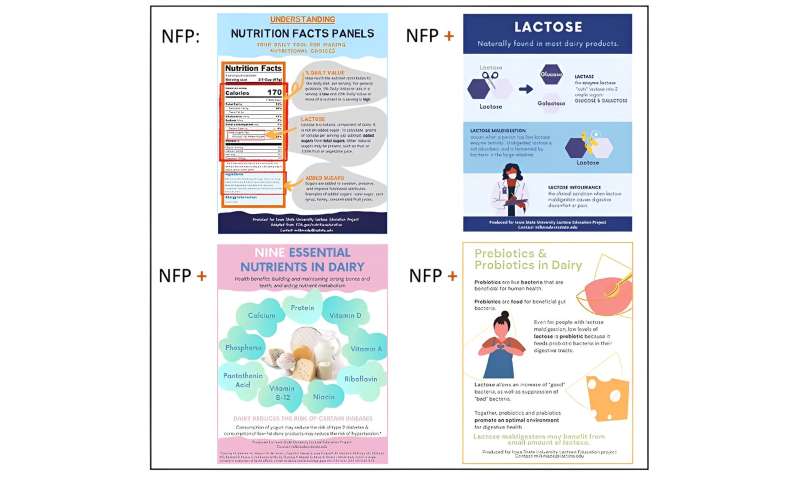Dairy nutrition educational messages help increase dairy product knowledge, purchasing, consumption

Although most Americans consume dairy and many dairy foods are rising in popularity, fluid milk consumption has seen a significant decline among U.S. consumers since the 1960s. To reverse this trend—and ensure consumers are getting adequate amounts of dairy in their diets—the dairy sector has developed educational materials to reach consumers through informational infographics and TV and print ads, and on social media.
But do these kinds of educational messages move the needle? A new study published in JDS Communications, demonstrates that when consumers are empowered with the facts on dairy's nutritional benefits, they buy and consume more dairy products—including cheese, ice cream, yogurt, and especially milk.
Lead investigator Stephanie Clark, Ph.D., who recently retired from the Department of Food Science and Human Nutrition, Iowa State University, explained, "We set out to educate those who consume an inadequate amount of dairy (less than three servings of dairy per day, according to The Dietary Guidelines for Americans) about various topics related to dairy nutrition, test their retention of information, and if increasing their knowledge around dairy motivates purchasing and consumption of dairy products."
Clark and the research team conducted their study in three phases: a screening survey, nominal focus groups, and a final follow-up survey with voluntary adult participants. In the first phase, a total of 4,542 adults completed the team's 15-question screening survey.
Clark outlined, "After the initial screening survey was closed, we funneled out a group of 195 participants for the nominal focus groups based on their interest in participating, lack of any food allergies, and the fact that they were reporting consuming less than three servings of dairy per day."
Four infographics were developed to help educate research participants about food labels and dairy concepts: nutrition facts panels, lactose maldigestion, nine essential nutrients, and prebiotics and probiotics.
During the nominal focus groups phase, facilitators administered a pre-survey to the participants, then walked them through the infographics lesson, before administering an ice cream acceptability test. Three samples of ice cream were tasted, and the facilitators explained the nutrition facts panels and ingredient statements of each, with attention given to the differences in lactose and added sugar among the samples.
Clark noted, "Unlike traditional focus groups, where data are collected from interacting panelists, our goal with the nominal format—involving limited interactions between participants—was to deliver educational information to the participants efficiently."
After the ice cream test, participants received a post-survey and another survey one month later.
The study results show that attending the nominal focus groups had a significant and positive effect on dairy product purchasing and consumption between the pre-survey and the one-month follow-up survey.
Clark elaborated, "Average dairy product purchasing increased to 4.4 servings per week, a 26% increase. Average consumption of each dairy product also increased—23% for cheese, 20% for ice cream, 26% for yogurt, and a staggering 53% increase for milk."
In total, overall participant dairy consumption rose to eight servings per week, or a 35% jump.
"The result for milk consumption was the stand-out in our results, with every focus group seeing milk consumption go up by at least one serving per week."
Despite these positive results, the research team was quick to point out that participants did not reach the recommended 21 servings of dairy per week. They stressed the importance of additional research to understand the long-term impacts of education on dairy in the diet, or if improvements to the educational materials or delivery might enhance their impact.
Overall, this study demonstrates that carefully constructed educational messages on the benefits and nutritional attributes of dairy foods can positively influence consumer behavior, leading to increased purchasing and consumption of dairy foods.
More information:
Jack Myers et al, Dairy nutrition educational messages help increase dairy product knowledge, purchasing, and consumption, JDS Communications (2023). DOI: 10.3168/jdsc.2023-0417
Provided by Elsevier